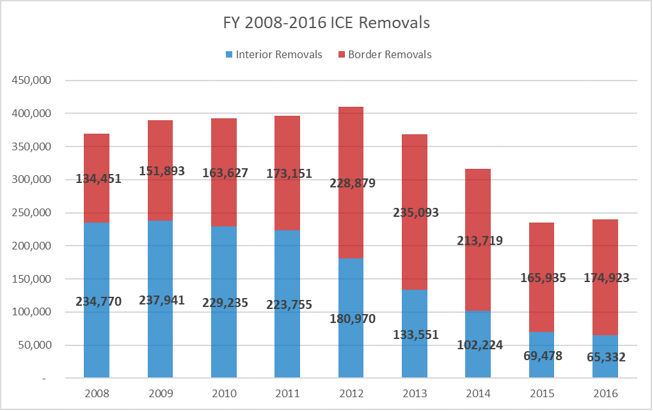
In late September, headlines were declaring that, notwithstanding President Trump’s strong rhetoric, the number of aliens removed from the United States in FY 2017 was going to be lower than it had been in previous years. A review of the removal statistics for the period between FY 2008 and FY 2016 helps to explain why, notwithstanding the president’s additional emphasis on immigration enforcement, the number of aliens removed from the United States, at least initially, may appear to be lower.

The figure above shows the number of removals by U.S. Immigration and Customs Enforcement (ICE) over the last nine fiscal years. It was prepared by the Center using chart six from the “ICE Enforcement and Removal Operations Report” for FY 2015, with the addition of the agency’s removal numbers from FY 2016, which were included at the end of the “Fiscal Year 2016 ICE Enforcement and Removal Operations Report“.
The most important statistic to track on this figure is the removals by ICE from the interior of the United States, which are marked in blue. These are aliens who are identified, apprehended, and removed by ICE from within the United States. The portion of the figure in red, on the other hand, represents aliens who were apprehended by U.S. Customs and Border Protection (CBP), either at the ports of entry or along the border, and handed over to ICE for removal.
Interior removals reached a high of 237,941 in FY 2009, and declined steadily for the next three years until they dropped precipitously in FY 2012, to 180,970. There was another precipitous drop off in FY 2013, when 47,419 fewer aliens were removed from the interior. This represented a 26 percent decline year to year between FY 2012 and FY 2013.
More importantly, the interior removal numbers for FY 2013 represented a 44 percent decline from FY 2009. The trend continued in FY 2014, when removals dropped to 102,224, an additional 23 percent decline year to year from FY 2013.
Interior removals plummeted after the issuance of the so-called “Policies for the Apprehension, Detention and Removal of Undocumented Immigrants“, by Homeland Security Secretary Jeh Johnson on November 20, 2014. Largely as a result of those policies, interior removals in FY 2015 decreased to 69,478, a 32 percent drop from the already anemic number of interior removals in FY 2014. The number of interior removals dropped, although not as significantly, in FY 2016, when they fell to 65,332, a whopping 72.5 percent decrease from FY 2009.
The importance of interior removals to effective immigration enforcement was explained by my colleague Jessica Vaughan in October 2013:
Americans understand that immigration enforcement in the interior is vital to the rule of law, preventing illegal employment, public safety, and national security. Experts estimate that about 60 percent of the approximately 11.7 illegal aliens who are residing here originally entered the country by illegally crossing a land border, and about 40 percent were admitted through an official port of entry and overstayed their visa or authorized admission. Most illegal aliens do not live in the border region; they are dispersed throughout the nation. Besides the seven million or so aliens who are working illegally, there are more than one million removable criminal aliens who are at large in U.S. communities as a result of release from jail or prison, or after having re-entered illegally after deportation.
If the interior removal numbers fell so dramatically, how did Barack Obama come to be known as the “deporter-in-chief“? By artificially inflating the number of removals by including removals from the border. As the Miami Herald reported:
[I]n 2014, Secretary of Homeland Security Jeh Johnson told Congress that figures tied to [ICE] that indicated a record of deportations under Obama were really not deportations, but quick turn-backs at the border of immigrants detained at or near the boundary line and then sent back to Mexico without a formal deportation process or order.
A review of the figure above demonstrates this phenomenon. The number of border removals increased from 134,451 in FY 2008 to a high of 235,093 in FY 2013, before dropping to 213,719 in FY 2014, and then to 165,935 in FY 2015.
The number of removals attributed to the Trump administration for FY 2017 will be lower, because the number of aliens apprehended attempting entry into the United States at the border has fallen dramatically from FY 2016, when 174,923 aliens were removed from the border.
Two categories of aliens are included in the number of border removals: aliens apprehended by U.S. Border Patrol (USBP) while, or directly after, entering the United States illegally; and aliens deemed inadmissible by Customs and Border Protection Officers at the ports of entry. CBP saw a drop in the number of apprehensions and inadmissibles in FY 2017 from a high of 66,712 in October 2016 (the month before the presidential election) to a low of 15,771 aliens in April 2017.
All told, there were 384,082 apprehensions and inadmissibles by CBP between October 1, 2016, and August 31, 2017, in FY 2017. This compares to a total of 559,695 apprehensions and inadmissibles in FY 2016, 445,819 apprehensions and inadmissibles in FY 2015, and 569,972 apprehensions and inadmissibles in FY 2014. While these figures are not directly comparable to the FY 2017 figures because the September 2017 numbers have not been released yet, it is clear that there has been a significant drop in the number of aliens apprehended and deemed inadmissible along the Southwest border this year, likely due to the president’s rhetoric and his emphasis on increased enforcement of the immigration laws, in particular on the use of detention for aliens seeking entry. Although this is a positive, this drop will be reflected in the total number of ICE removals under the first year of the Trump administration, assuming that the current administration continues to count removals in the same manner that the Obama administration did.
The number of removals from the interior, however, is likely to increase, but not enough to offset the decrease in the number of aliens deported after attempting illegal entry. The Washington Post reported in September that between January 22 and September 9, 2017, “officials deported nearly 54,000 immigrants from the interior, a 34 percent increase over the same period last year,” and that alien “arrests … are up more than 40 percent this year.” These numbers are incomplete, because they do not include the number of interior removals for the better part of the first four months of the fiscal year, or for the last three weeks of FY 2017. The year-to-year increase, however, strongly suggests that interior removals will be up significantly in FY 2017.
Critics of the president’s immigration policies seem to want to argue that those policies are both too harsh and at the same time ineffective. A fuller picture of whether those policies have been successful or not will be available in December when the Department of Homeland Security releases its full statistics for FY 2017. Given the fact that the president’s policies appear to have both dissuaded aliens from entering the United States illegally, and at the same time increased the number of removals from the interior, however, there is room for hope for their ultimate success.
Click HERE to view more.
You can publish this article on your website as long as you provide a link back to this page.

Be the first to comment